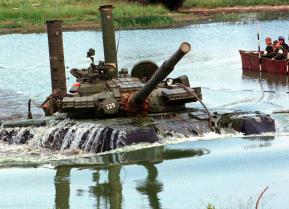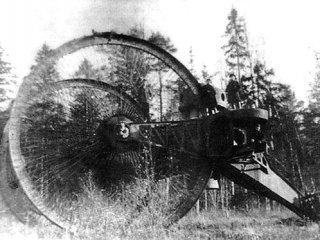Meet Russia's World War I Lebedenok 'Tzar Tank' (Yes, the Picture Is Real)
" Within two years the Russian Empire was no more and the single prototype remained stuck in a swamp until 1923 when it was salvaged for scrap. While it would have no doubt, intimidated enemy soldiers, it was simply an impractical creation for the modern battlefield."
Even 100 years later, most tanks developed during the First World War remain familiar. Even with the lack of turrets on British and German tanks, the profiles remain familiar enough, and it is easy to see how these massive hulking vehicles evolved into today's modern main battle tanks (MBT). Then there was the Russian Lebedenko, or "Tsar Tank," which goes down in the annals of military hardware as the most unusual, and arguably most impractical armored vehicle ever devised.
Whereas the tanks of France, Great Britain, and even Germany utilized the familiar caterpillar treads, the Russian designers instead opted for massive wheels that could quickly cross most any terrain. It was a concept that seems simply hare-brained in retrospect.
While the German 100-ton "Maus" tank still holds the record for the largest tank ever devised, the Tzar Tank wasn't far behind in terms of sheer size. It should also be noted that this project wasn't an attempt to build an even "bigger" tank, as it began completely independent of the other tanks that were developed during the First World War, and in fact, the Tzar Tank was actually the first to be designed and developed – even if it wasn't technically a tank at all.
The concept of such a monstrous armored vehicle actually began even before the war broke out. It was the hare-brained brainchild of four Russian designers who included Nikolai Zhukovky, Alexander Mikuli, Nikolai Lebedenko, and Boris Stechkin. While the four men have been credited it was Lebedenko whose name has been forever linked to the vehicle – likely for good and bad!
As noted it wasn't really a tank in the traditional sense, but rather a massively oversized gun carriage that resembled a tricycle with one small double-wheel at the back and two very large front spoked wheels that were almost nine meters in diameter. The larger pair of wheels was attached to the hull, which was described as being shaped like a tuning-fork. The thinking of the designers was that this vehicle could cross practically any and all obstacles.
It was originally dubbed the "Nepotir" but soon came to be known the Lebedenko, or The Tzar – as in Tzar (or Czar) Nicholas II of Russia, who financed the construction of the one and only prototype after seeing a much smaller model. The various stories suggest Nicholas was impressed by the small toy version that was able to scale obstacles that include a number of books. Lebedenko was given a reported 250,000 rubles – roughly $125,000, which was an enormous sum at the time.
Given the shortages that existed in the Imperial Russian Army the money could have been better spent on almost anything else, but it should be remembered that all sorts of ideas were considered to break the stalemate of the front lines during the First World War. The original tank program began as the Landship committee that called for a vehicle that could have weighed 300 tons. By comparison, the Lebedenko could almost be seen as downright practical.
Another notable point is that the Russian developers were still somewhat frugal in creating the prototype behemoth. It used two 240hp Maybach engines, which had been salvaged from German Zeppelins. On firm ground, this would enable a top speed of 11 miles an hour – slow by today's standards, but speedy for its day.
The design called for the hull to be lined with steel armor while it was to be equipped with two 76.2mm cannons, each armed with 60 shells. In addition, a line of 7.62mm Maxim machine guns was to protect the vehicle from enemy infantry. To keep the beast rolling forward and to operate the weapons required a crew of 15.
The construction progressed quickly and the prototype was finished in July 1915. However, because of weight and size it had to be transported in sub-assemblies and reassembled at the testing site, where it was found it actually exceeded calculations by some 50% due to the use of thicker metals. It stood 30 feet tall and rather than a weapon of war looked something "like Paul Bunyan's tricycle" – albeit a well-armed one at that.
Despite the increased weight, the testing started well, and the vehicle was able to move over firm ground and even crushed a tree like it was a twig. Then it hit a softer patch of dirt and the smaller double rear wheels became stuck in a ditch. The engines proved too small and lacked the power to free the massive vehicle.
Two of the designers, Mikulin and Stechkin, were charged with developing more powerful engines but work was never completed. The military noted numerous flaws – in addition to the costs, the vehicle was deemed too vulnerable to enemy artillery fire. The project was abandoned just as the British Landship program developed Little Willie, the first prototype tank, which was far smaller but more ideally suited to the modern battlefield.
Within two years the Russian Empire was no more and the single prototype remained stuck in a swamp until 1923 when it was salvaged for scrap. While it would have no doubt, intimidated enemy soldiers, it was simply an impractical creation for the modern battlefield.
Peter Suciu is a Michigan-based writer who has contributed to more than four dozen magazines, newspapers and websites. He is the author of several books on military headgear including A Gallery of Military Headdress, which is available on Amazon.com.
Image: Wikicommons/Creative Commons.


